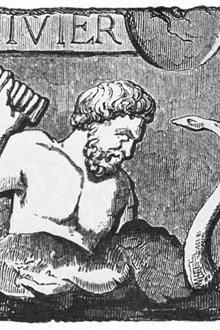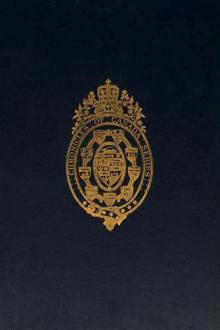Three Thousand Years of Mental Healing by George Barton Cutten (best large ereader txt) 📕

- Author: George Barton Cutten
- Performer: -
Book online «Three Thousand Years of Mental Healing by George Barton Cutten (best large ereader txt) 📕». Author George Barton Cutten
Tertullian (160-220) insisted that a malevolent angel was in constant attendance upon every person, but in writing to the pagans in a time of persecution he challenged his opponents to bring forth any person who was possessed by a demon or any of those prophets or virgins who were supposed to be inspired by a divinity. He asserted that all demons would be compelled to confess their diabolical character when questioned by any Christians, and invited the pagans, if it were otherwise, to put the Christian immediately to death, for this, he thought, was the simplest and most decisive demonstration of the faith.
Lecky tells us of the attitude of the fathers toward demonism in the following words: "Justin Martyr, Origen, Lactantius, Athanasius, and Minucius Felix, all in language equally solemn and explicit, call upon the pagans to form their own opinions from the confessions wrung from their own gods. We hear from them, that when a Christian began to pray, to make the sign of the cross, or to utter the name of his Master in the presence of a possessed or inspired person, the latter, by screams and frightful contortions, exhibited the torture that was inflicted, and by this torture the evil spirit was compelled to avow its nature. Several of the Christian writers declare that this was generally known to pagans."6
Origen (185-254) said: "It is demons which produce famine, unfruitfulness, corruptions of the air, pestilence; they hover concealed in clouds in the lower atmosphere, and are attracted by the blood and incense which the heathen offer to them as gods." He thought, though, that Raphael had special care of the sick and the infirm. Cyprian (186-258) charged that demons caused luxations and fractures of the limbs, undermined the health, and harassed with diseases. Up to this time it was the privilege of any Christian to exorcise demons, but Pope Fabian (236-250) assigned a definite name and functions to exorcists as a separate order. To-day the priest has included in his ordination vows those of exorcist. Gregory of Nazianzus (329-390) declared that bodily pains are provoked by demons, and that medicines are useless, but that demoniacs are often cured by laying on of consecrated hands. St. Augustine (354-430) said: "All diseases of Christians are to be ascribed to these demons; chiefly do they torment fresh-baptized Christians, yea, even the guiltless new-born infants."
Baltus7 says: "De tous les anciens auteurs ecclésiastiques, n'y en ayant pas un qui n'ait parlé de ce pouvoir admirable que les Chrétiens avoient de chasser les démons," and Gregory of Tours (538-594) says that exorcism was common in his time, having himself seen a monk named Julian cure by his words a possessed person. This testimony of Gregory's concerning the prevalence of exorcisms at the end of the sixth century is interesting in view of the facts that the Council of Laodicea, in the fourth century, forbade any one to exorcise, except those duly authorized by the bishop, and that in the very beginning of the fifth century a physician named Posidonius denied the existence of possession. The fathers of the church, however, ridiculed the solemn assertion of physicians that many of these alleged demoniacal infirmities were attributable to material agencies, and were fully persuaded in their own minds that demons took possession of the organism of the human body.
At about this time, such a broad-minded man as Gregory the Great (540-604) solemnly related that a nun, having eaten some lettuce without making the sign of the cross, swallowed a devil, and that, when commanded by a holy man to come forth, the devil replied: "How am I to blame? I was sitting on the lettuce, and this woman, not having made the sign of the cross, ate me along with it." This is but an example of the ideas concerning the entrance of demons into the possessed.8 Besides the possibility of being taken into the mouth with one's food, they might enter while the mouth was opened to breathe. Exorcists were therefore careful to keep their mouths closed when casting out evil spirits, lest the imps should jump into their mouths from the mouths of the patients. Another theory was that the devil entered human beings during sleep, and at a comparatively recent period a king of Spain, Charles II (1661-1700), kept off the devil while asleep by the presence of his confessor and two friars.9
Shortly before the reign of Gregory, there came into vogue the fashion of exorcising demons by means of a written formula rather than by the earlier means of making the sign of the cross and invoking the name of Jesus. The theory of demonology was never very clear nor consistent. By some it was claimed that in the practice of the magical arts evil spirits provided cure for sickness, others maintained that they could not heal any diseases, and hence the true test of Christianity was the ability to cure bodily ills. A compromise position was that demons were only successful in eliminating diseases which they had themselves caused. There was not a little doubt in some cases about the character of the possessing spirits, and it behooved people to be careful; demons might use men as habitations, and while posing as good angels vitiate health and provoke disease.
At the beginning of the seventh century, we have an account of an exorcism by St. Gall (556-640), and during the Carlovingian age the healing at Monte Cassino was based on the Satanic origin of disease. When the conversion of northern races to Christianity began, demonology received a stimulus. An unlimited number of demons, similar in individuality and prowess, were substituted for the pagan demons, and the pagan gods were added as additional demons. When proselytes were taken into the church, care was taken to exorcise all evil spirits. During the baptismal service the Satanic hosts, as originators of sin, vice, and maladies, were expelled by insufflation of the officiating clergyman, the sign of the cross, and the invocation of the Triune Deity. The earliest formulas for such expulsion directed a double exhalation of the priest.10
In all epidemics of the Middle Ages, such persons as were afflicted by pestilent diseases were declared contaminated by the devil, and carried to churches and chapels, a dozen at a time, securely bound together. They were thrown upon the floor, where they lay, according to the attestation of a pitying chronicler, until dead or restored to health.
Unsound mind was universally accepted as a specific distinction of diabolical power, and caused by the corporeal presence of an impure spirit. Imbeciles and the insane were, throughout the Middle Ages, especially conceded to be the abode of avenging and frenzied demons. In aggravated cases, the actual presence of the medicinal saint was necessary; in less vexatious maladies, the bare imposition of hands, accompanied by plaintive prayer, quickly healed the diseased.11
As early as the fifth century before Christ, Hippocrates of Cos asserted that madness was simply a disease of the brain, but notwithstanding the reiteration of this scientific truth the church repudiated it, and as late as the Reformation, Martin Luther maintained that not only was insanity caused by diabolical influences, but that "Satan produces all the maladies which afflict mankind." Even much later, however, when other diseases were assigned a physical origin, insanity was still thought to be demoniacal possession. As late as Bossuet's time, lunacy was thought to be the work of demons. The cultured and progressive Bishop of Meaux, while trying to throw off the shackles of superstition, delivered and published two great sermons in which demoniacal possession is defended. To show how the idea has clung, notwithstanding the advancement and enlightenment of late years, we may notice a trial which took place at Wemding, in southern Germany, in 1892, of which White tells us.
"A boy had become hysterical, and the Capuchin Father Aurelian tried to exorcise him, and charged a peasant's wife, Frau Herz, with bewitching him, on evidence that would have cost the woman her life at any time during the seventeenth century. Thereupon the woman's husband brought suit against Father Aurelian for slander. The latter urged in his defence that the boy was possessed of an evil spirit, if anybody ever was; that what had been said and done was in accordance with the rules and regulations of the Church, as laid down in decrees, formulas, and rituals sanctioned by popes, councils, and innumerable bishops during ages. All in vain. The court condemned the good father to fine and imprisonment."12
I cannot refrain from quoting in this connection the now famous epitaph of Lord Westbury's, suggested by the decision given by him as Lord Chancellor in the case against Mr. Wilson in which it was charged that the latter denied the doctrine of eternal punishment. The court decided that it did "not find in the formularies of the English Church any such distinct declaration upon the subject as to require it to punish the expression of a hope by a clergyman that even the ultimate pardon of the wicked who are condemned in the day of judgment may be consistent with the will of Almighty God." The following is the epitaph:
"RICHARD BARON WESTBURY,
Lord High Chancellor of England.
He was an eminent Christian,
An energetic and merciful Statesman,
And a still more eminent and merciful Judge.
During his three years' tenure of office
He abolished the ancient method of conveying land,
The time-honored institution of the Insolvents' Court,
And
The Eternity of Punishment.
Toward the close of his earthly career,
In the Judicial Committee of the Privy Council,
He dismissed Hell with costs,
And took away from Orthodox members of the
Church of England
Their last hope of everlasting damnation."13
In the Middle Ages there was a strange and incongruous mixture of medicine and exorcism. Notice the following prescriptions:
"If an elf or a goblin come, smear his forehead with this salve, put it on his eyes, cense him with incense, and sign him frequently with the sign of the cross."
"For a fiend-sick man: When a devil possesses a man, or controls him from within with disease, a spew-drink of lupin, bishopwort, henbane, garlic. Pound these together, add ale and holy water." "A drink for a fiend-sick man, to be drunk out of a church bell: Githrife, cynoglossum, yarrow, lupin, flower-de-luce, fennel, lichen, lovage. Work up to a drink with clear ale, sing seven masses over it, add garlic and holy water, and let the possessed sing the Beati Immaculati; then let him drink the dose out of a church bell, and let the priest sing over him the Domine Sancte Pater Omnipotens."14
Three methods of driving out demons from the insane were used: the main weapon against the devil and his angels has always been exorcism by means of ecclesiastical formula and signs. These formulas degenerated at one time to the vilest cursings, threatenings, and vulgarities. A second means was by an effort to disgust the demon and wound his pride. This might simply precede the exorcism proper. To accomplish this purpose of offending the demons, the most blasphemous and obscene epithets were used by the exorcist, which were allowable and perfectly proper when addressing demons. Most of these are so indecent that they cannot be printed, but the following are some examples:
"Thou lustful and stupid one,... thou lean sow, famine-stricken and most impure,... thou wrinkled beast, thou mangy beast, thou beast of all beasts the most beastly,... thou mad spirit,... thou bestial and foolish drunkard,... most greedy wolf,... most abominable whisperer,... thou sooty spirit from Tartarus!... I cast thee down, O Tartarean





Comments (0)